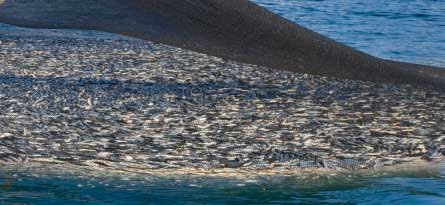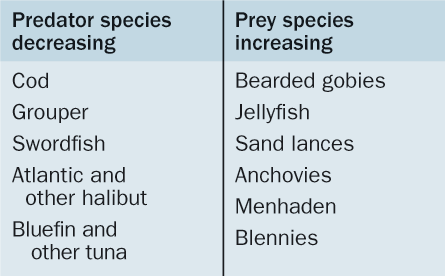Big Fishing Yields Small Fish
Researchers map predator loss and predict unstable oceans
Sharks, billfish, cod, tuna and other fish-eating fish — the sea’s equivalents to lions on the Serengeti — dominated the marine world as recently as four decades ago. They culled sick, lame and old animals and kept populations of marine herbivores in check, preventing marine analogs of antelopes from overgrazing their environment.


But the reign of large predators now appears over — probably forever.
Two new studies, presented in February in Washington, D.C., at the annual meeting of the American Association for the Advancement of Science, suggest that the ecologically valuable marine lions are rapidly disappearing. Another pair of related analyses point to physical and chemical changes, driven by Earth’s warming climate, that threaten to diminish the maximum size that any species — predator or prey — can attain.
For decades, fisheries biologists have been chronicling the overfishing of large predatory fish by species or region (SN: 6/4/05, p. 360). Villy Christensen of the University of British Columbia in Vancouver and his colleagues have now offered the first worldwide analysis of predator loss.
The team identified more than 200 separate snapshots of the marine food web taken from 1880 to 2007, studies that describe and quantify all the constituents of a local or regional marine ecosystem. Together, the research points to a steady, slow loss of roughly 10 percent of the top predator fish in the world’s oceans between 1910 and 1970, Christensen reported at the meeting. At that point, fishing fleets began adopting more efficient gear and the loss of predators skyrocketed, he said.
Today, predatory fish exist at one-third of their 1910 abundance. “We see no indication that things are improving,” Christensen said. “It’s a pretty bleak situation.” By midcentury, he predicts, predators will be rare.
But the ocean won’t be empty. The loss of big fish has been largely offset, at least in biomass, by an explosion in the abundance of small, prey fish, including everything from anchovies to blennies.
The trend is disturbing, Christensen said, because the species that are disappearing are the ones that people most prefer to eat and the ones that can prevent smaller fish from overrunning and potentially destroying their ecosystems.
Such changes, Christensen said, could have been predicted based on what’s known about how ecosystems respond to the culling of predators. But until now “we just haven’t had the numbers to show that — certainly not at the global level.”
Upping the effort
Fisheries biologist Reg Watson, also of the University of British Columbia, has been acquiring numbers of a different but complementary type. His team has quantified how aggressively fishing has increased since the 1950s.
A steep escalation in the effort that fleets employ, he reported at the AAAS meeting, has allowed them to continue supplying consumers’ large and growing demand for predator species against a backdrop of declining stocks.
During the mid-20th century, global harvests totaled about 16 million metric tons per year and came from fishing almost exclusively along coasts. Maps Watson showed at the meeting illustrated that by the 1980s, intensive fishing had exploded into most of the open oceans. Reliance on more efficient gear such as trawlers or helicopter-guided purse seines, which can mine the water of almost all fish within their reach, has boosted the intensity of the effort. By the 1990s, the total global harvest had climbed to roughly 80 million tons per year. Despite steadily increasing effort, Watson says, the catch stagnated in the 1990s — and has yet to improve.
Watson cited 2006 figures indicating that the commercial industry hauled in 76 million tons of seafood, about 7 trillion individuals. This leveling off alongside rising efforts is further evidence that predatory fish are becoming scarcer, he concluded.
Feeling the heat
The real wild card in predicting the future of fisheries is climate change.
Predatory fish eat smaller ones, which in turn feed on tinier ones. Further down this food web are fish that feed on plankton — tiny floating animals and plantlike organisms. These plankton, the base of the living marine world, derive much of their nutrition from organic matter that wells up from the ocean’s cold depths.
In a warmer world, water will become less dense. Heavier rains, projected in and near the tropics, could lead to a freshening of the upper seas. Together, such changes should foster a stratification of ocean layers, with a less salty layer stably topping a saltier one, geochemist Jorge Sarmiento of Princeton University noted at the AAAS meeting. This stratification would make it harder for nutrients to reach the surface, he said.
He compared various projections by five computer programs that attempt to predict ocean features in a changing climate, including a new program under development by his team. When ocean surface temperatures 2 degrees Celsius warmer than today’s were fed into the programs, every simulation showed a fall in the production of large plankton, the size that fish eat. Globally, the drop will average 1 or 2 percent, Sarmiento said, although regionally it could hit 16 percent. Fewer large plankton will mean less food for fish, thus limiting their size.
William Cheung of the University of East Anglia in Norwich, England, has fed certain chemical and other features projected by Sarmiento’s team into another computer program. It probes global warming’s potential impact on more than 5,000 commercial fish stocks, covering 1,060 species.
Cheung’s model projects that the ultimate size of most fish might fall by about 10 percent, he reported at the meeting.
Until, that is, he factored in ocean acidification.
Ocean surface waters are already experiencing some acidification, because of increased air concentrations of carbon dioxide (SN: 3/15/08, p. 170), a prevalent greenhouse gas. At least some sensitive fish will have to expend substantial energy clearing acid from their bodies, Cheung said, meaning that energy can no longer be devoted to growth. When his analyses accounted for this, predicted drops in fish growth in many regions reached 30 or 40 percent.
“In our model, more than 75 percent of commercial stocks would experience some reduction in body size,” Cheung said. And the effects could be widespread, he reported, hitting fish in what are currently some of the ocean’s most productive areas.
Warming could stress fish even if levels of chemicals in surface water don’t change. In warmer waters, fish move more and breathe faster, which increases their oxygen demand. But owing to the gills’ fixed surface area, Sarmiento said, there is a limit to how much extra oxygen the swimmers can take in. He predicts, for this reason and others, that warming will propel some fish to find cooler neighborhoods.
Cheung reported that if waters warm an average of 2 degrees Celsius, more than 50 percent of stocks could be expected to move — by up to 40 kilometers per decade. Some fish may become more costly for fishers to get, while others may shift from one country’s territory to another.
Clearly, Christensen said, climate change is going to radically alter the oceans. They’ll become less stable chemically even as overfishing is making them less stable ecologically.
Watson agreed. When it comes to fisheries health, “many alarm bells are ringing.”